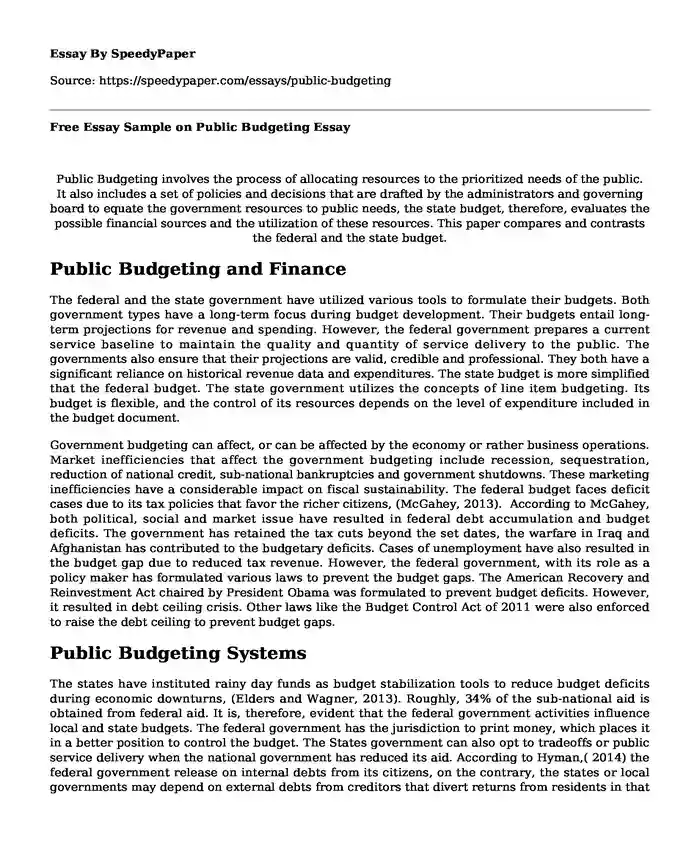
| Type of paper: | Essay |
| Categories: | Finance Government Budgeting |
| Pages: | 3 |
| Wordcount: | 623 words |
Public Budgeting involves the process of allocating resources to the prioritized needs of the public. It also includes a set of policies and decisions that are drafted by the administrators and governing board to equate the government resources to public needs, the state budget, therefore, evaluates the possible financial sources and the utilization of these resources. This paper compares and contrasts the federal and the state budget.
Public Budgeting and Finance
The federal and the state government have utilized various tools to formulate their budgets. Both government types have a long-term focus during budget development. Their budgets entail long-term projections for revenue and spending. However, the federal government prepares a current service baseline to maintain the quality and quantity of service delivery to the public. The governments also ensure that their projections are valid, credible and professional. They both have a significant reliance on historical revenue data and expenditures. The state budget is more simplified that the federal budget. The state government utilizes the concepts of line item budgeting. Its budget is flexible, and the control of its resources depends on the level of expenditure included in the budget document.
Government budgeting can affect, or can be affected by the economy or rather business operations. Market inefficiencies that affect the government budgeting include recession, sequestration, reduction of national credit, sub-national bankruptcies and government shutdowns. These marketing inefficiencies have a considerable impact on fiscal sustainability. The federal budget faces deficit cases due to its tax policies that favor the richer citizens, (McGahey, 2013). According to McGahey, both political, social and market issue have resulted in federal debt accumulation and budget deficits. The government has retained the tax cuts beyond the set dates, the warfare in Iraq and Afghanistan has contributed to the budgetary deficits. Cases of unemployment have also resulted in the budget gap due to reduced tax revenue. However, the federal government, with its role as a policy maker has formulated various laws to prevent the budget gaps. The American Recovery and Reinvestment Act chaired by President Obama was formulated to prevent budget deficits. However, it resulted in debt ceiling crisis. Other laws like the Budget Control Act of 2011 were also enforced to raise the debt ceiling to prevent budget gaps.
Public Budgeting Systems
The states have instituted rainy day funds as budget stabilization tools to reduce budget deficits during economic downturns, (Elders and Wagner, 2013). Roughly, 34% of the sub-national aid is obtained from federal aid. It is, therefore, evident that the federal government activities influence local and state budgets. The federal government has the jurisdiction to print money, which places it in a better position to control the budget. The States government can also opt to tradeoffs or public service delivery when the national government has reduced its aid. According to Hyman,( 2014) the federal government release on internal debts from its citizens, on the contrary, the states or local governments may depend on external debts from creditors that divert returns from residents in that jurisdiction. Hyman further explains that settling debts reduces revenues and increases the budget gaps, which influences the state’s financial obligations and my result into bankruptcy. The rainy day funds can also work for the national government to extend its commercial sources. This can be achieved through external donors or creditors. However, it is crucial to enforce laws that control the dependency on external sources.
References
Elder, E. M., & Wagner, G. A. (2013, December). Revenue cycles and risk-sharing in local governments: An analysis of state rainy day funds. National Tax Journal, 66(4), 939-960
Hyman, D. N. (2014). Public finance: A contemporary application of theory to policy (11th ed.). Stamford, CT: Cengage Learning
McGahey, R. (2013). The political economy of austerity in the United States. Social Research, 80(3), 717- 748.
Cite this page
Free Essay Sample on Public Budgeting. (2017, Oct 05). Retrieved from https://speedypaper.com/essays/public-budgeting
Request Removal
If you are the original author of this essay and no longer wish to have it published on the SpeedyPaper website, please click below to request its removal:
- Free Essay on Big Data Analytics in Enhancing Nigeria's Economic Growth
- Leadership Skills in Religion - Essay Example
- Education Essay Sample: Organizational Structure of a School District
- Free Essay Sample: Analysing Budweiser and American Beer Industry
- The Molarity of Abortion by Mark T. Brown, Free Essay
- Essay Sample on Organizational Direction: Mission, Goals, and Objectives
- Essay Sample on Project Management for Construction Paddington Square
Popular categories




